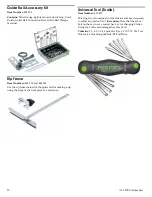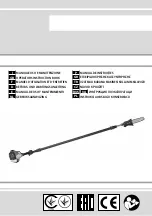
Adjusting the Blade Position
Adjusting the position of the blade with respect to the guide
rail system consists of two interrelated adjustments—Blade
Distance and Blade Skew. Both of these adjustments are
completed at the factory and should be altered only if the saw
is damaged, modified, or needs to match other Festool
products.
10
ATF 55E Circular Saw
Figure 12
12-a
Sole Plate Rear Adjustment Screws.
12-b
Sole Plate Front Adjustment Screws.
12-c
Bevel Locking Knob
(front knob not visible).
12-d
Bevel Angle Pointer Screw.
Blade Distance
In most cases, only the blade skew needs to be adjusted (the
second half of this procedure). Adjust the blade distance only
if any of the following are true:
►
The blade is not cutting along the splinter guard,
►
A new saw needs to be matched to an existing saw or
guide rail system, or
►
To restore the factory default distance prior to replacing
the splinter guard. (Do not install a new splinter guard
until after this procedure is complete.)
1.
Loosen (but do not remove) the four sole plate adjustment
screws (12-a and 12-b), the bevel angle pointer screw (12-
d), and the two bevel locking knobs (12-c).
2.
Slide the sole plate in or out until one of the following
conditions is met (depending on the need for this
adjustment):
►
For the factory default setting, align the tips of the
hinge blocks (13-a) to be flush with the tips of the
hinge brackets (13-b) as show with the arrows (13-c).
►
To match existing splinter guards, set the front edge of
the blade so it touches the splinter guard. (This
requires setting the saw on the guide rail.)
►
For either case described above, the rear of the blade
should be slightly farther away from the splinter
guard than the front. This will be adjusted in the
"Blade Skew" adjustment.
3.
Tighten the two bevel locking knobs, but leave the rest
of the screws loose. (The bevel locking knobs will hold
the adjustments in place until the rest of the procedure
is complete.)
4.
Continue the rest of this adjustment by completing the
Blade Skew adjustment described below. After
completing the Blade Skew adjustment, return to step
5 below.
5.
After both parts of this adjustment are complete, and
if it is necessary, install and trim a new splinter guard
as described on page 11.
Blade Skew
This procedure can be completed without completing the
Blade Distance adjustment. However, if the Blade Distance
has been adjusted, then this procedure is mandatory.
1.
Loosen (but do not remove) the four sole plate
adjustment screws (12-a and 12-b) and the bevel angle
pointer screw (12-d).
Do not loosen
the bevel locking
knobs, as these will hold the existing adjustment from
moving until required.
2.
With the saw unplugged and placed on the guide rail,
verify that the blade will not cut into the splinter
guard (unless desired or expected) by manually
turning the blade.
►
If the front of the blade will cut into the splinter guard,
you have the option to proceed with the adjustment,
or stop and perform the Blade Distance Adjustment.
►
If the back of the blade will cut into the splinter guard,
then loosen the rear bevel adjustment knob and move
the rear of the saw away from the guide rail.
3.
Using the guide rail, carefully cut a piece of wood:
►
For this adjustment, it is imperative that the guide rail
does not move after the cut is complete. You must
clamp the guide rail to the workpiece!
►
For best results, the material should have a consistent
center, such as Medium Density Fiberboard (MDF),
plastic, or solid lumber.
►
The more teeth on the blade, the more accurate this
adjustment will be. Use a blade with the highest tooth
count that is acceptable for the type of material being
cut.







































